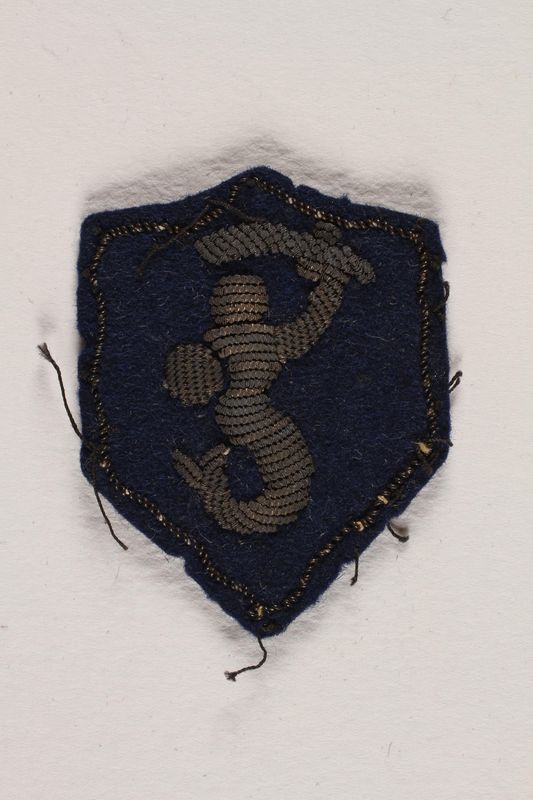Overview
- Brief Narrative
- 2nd Polish Corps red patch with the Warsaw Mermaid, Syrenka, the city coat of arms, worn by by Dr. Salomon Slowes, who was a medical officer in the Polish Army and then the 2nd Polish Corps, circa 1939-1945. The patch was approved for use by the Polish Army of the East in December 1942, around the time Anders Army became the 2nd Polish Corps, British Army. The patch was re-approved for use in Italy in March 1944. It was worn on the left sleeve. Slowes was called up shortly before Germany invaded Poland on September 1, 1939. Three weeks later, the Soviet Union invaded. Slowes was captured by the Soviets and interned in Kozel'sk, Pavlishchev Bor, and Gryazovets prisoner of war labor camps. After Germany invaded the Soviet Union in June 1941, Slowes was released as part of an amnesty granted to Polish prisoners to aid the Soviet war effort. He joined the Polish Army of the East, known as Anders Army, a volunteer military unit. Slowes, who was an oral and facial surgeon, set up clinics in every place the Army made camp. In August 1942, the unit left Soviet territory and became the 2nd Polish Corps, British Army. In February 1944, his unit deployed from North Africa to join the British 8th Army in the Italian Campaign. The Corps fought its way north and was honored for heroism in the May 1944 Battle of Monte Cassino. The Corps was in Italy on May 7, 1945, when the war ended. Slowes was awarded several medals by the British and Polish governments for his service. He settled in Palestine after the war.Slowes was awarded several medals by the British and Polish governments for his service. He settled in Palestine after the war.
- Date
-
use:
after 1942 December-approximately 1947
- Credit Line
- United States Holocaust Memorial Museum Collection, Gift of Salomon Slowes
- Contributor
-
Subject:
Salomon Slowes
- Biography
-
Salomon (Shalom) Wlodzimierz Slowes was born November 20, 1909, in Grajewo, Poland, to Mosze Dow and Malka Jezierska Slowes, who married in 1907. Mosze was born in 1872 in Shmerinka, Belarus, Russia, and had a brother Israel, married to Riwa Guterman and two sisters. Salomon’s mother Malka was born in 1886 in Suwalki, Russia, later Poland, to Abraham Yehuda and Mera Kijanowska Jezierski. She had several siblings: Jose, married to Dora, Michal, married to Rachel Slowetycka, Fania, married name Serok, Gitl, married name Oblaska, with two daughters, Lipka-Luba, who married Moszes Kremer and had a son Abram, and Zeidke. Both of Salomon’s parents were dentists; his father, a surgeon, was educated in Odessa and his mother in Warsaw. Salomon had an older sister Dina Beila, born 1908, and a younger brother Abraham, born 1913. The family was Jewish, kept a kosher home, spoke primarily Yiddish, and it was a closeknit, extended family. The Slowes family moved to Vilna in 1914, where his father Mosze became head of the dentistry school at Vilna University. Salomon’s youngest sister Roza was born in 1917 in Vilna. In 1920, Vilna was annexed by Poland. Salomon graduated from a Tarbut school, a secular Hebrew language school in 1923, then attended a Jewish high school to prepare for state exams. In 1928, he enrolled at Stefan Batory University in Vilna where he studied dentistry and medicine. He joined the Jordania Club, Union of Zionist Revisionists. His brother Abraham had joined Tiferet Bachurim, a religious Zionist movement, in reaction to the growing antisemitism in Poland. In 1930, Abraham left for Palestine where he studied engineering at the Technion in Haifa. Also in 1930, Salomon’s sister Dina married Miron Rubinowicz; they were both teachers and later had a son Elchanan. Salomon’s maternal uncle Josef and his wife Dora left for the United States sometime prior to 1939. Salomon graduated with a specialty in surgery in 1934. He went to Vienna for advanced training and was appointed assistant in the Face and Jaw Surgery unit, University Hospital, Vilna. Second Lieutenant Slowes also completed mandatory military service, serving at a clinic from February 1936-February 1938. On July 12, 1938, Salomon’s sister Roza, a teacher, married Szymon Braitbard.
The Polish Army began mobilizing in March 1939, shortly after Germany annexed a province of Czechoslovakia. Salomon was called up in August and went on duty as a military physician. On September 1, 1939, Germany invaded Poland. Salomon’s unit defended Wyszkow, south of Bialystok, and then retreated eastward. The Soviet Union invaded from the east and, on September 22, captured Salomon’s unit near Wlodimierz Wolunski. Thousands of Polish prisoners of war were loaded on a train which arrived in Gryazovets on October 3. Salomon exchanged his leather boots for large, warm, felt lined boots in which he could hide papers. After two weeks, they were sent to Vologda for two weeks, October 18-November 1. They arrived on November 2 in Koziel'sk camp, where they were interrogated by the NKVD, the secret police. Salomon and another POW, Boleslaw Szarecki, worked in the camp clinic under the supervision of a female Soviet doctor. On April 26, 1940, Salomon and 400 other POWs were taken to Pavlischev Bor and two other camps. On June 16, they were transferred back to Gryazovets.
In June 1941, Germany invaded the USSR. The Soviets issued an amnesty to Polish POWs and forced laborers. Some were needed to work in factories and agriculture to replace the Russians mobilized into the Red Army. Others were released to join the fight against the Germans. An agreement was signed between the Polish Government in Exile and the Soviet government to form a Polish army under the command of General Wladyslaw Anders, who had been a POW in Lublianka. The commandant at Gryazovets distributed compensatory payments to the Polish Army officers. On August 25, Anders came to Grazoviets to recruit for the new Army, which Salomon joined. On September 2, Salomon left the camp, and with other recruits, travelled to Totskoye, Kazakhstan. From October 12-November 1941, Salomon worked at a dental clinic in Totskoye, then relocated to the Army’s headquarters in Buzuluk. In August 1942, the Army travelled to Krasnovodsk in Turkmenistan. Salomon also worked in a clinic in Yangi-Jul. On August 17, they left Soviet territory, crossing the Caspian Sea to Pahlevi, Iran. At this point, the Army was placed under the control of the British government and became the Polish Second Corps, a unit of the British Army, affiliated with the Polish Armed Forces in the West. The troops travelled through Iraq and Iran as they received training from British forces. Salomon directed surgical departments for victim of face and jaw injuries at the Red Cross hospital in Teheran and the other countries through which the Army moved. In September 1943, they reached Palestine. In February 1944, the unit moved to Egypt and North Africa. The Polish soldiers were now fully trained and, on February 18, joined the Italian Campaign, commanded by the Eighth British Army. The Corps fought their way north through Italy. They experienced high casualties, especially in the May 1944 final Battle of Monte Cassino, the fourth assault on those German defenses since January. In July, Salomon was surgeon and head of the Maxillo-Facial Surgical Unit no. 2 at a military hospital in Palagia, Italy.
Salomon was awarded several medals for his service from both the British and Polish governments, including the Monte Cassino Cross, number 42770. The war ended in May 1945. Most of Salomon’s family had not survived. His mother Malka and sisters Dina and Roza, and their families, were murdered in the massacres in Ponary near Vilna, probably in the fall of 1941. His father Mosze was deported to Klooga concentration camp in Estonia, where he perished. His maternal aunt Gitka, and her husband Israel Obloska, were deported to Wlodzimierz Wolynski, where they perished.
Salomon was discharged on June 26, 1945, and given permission to go to Palestine. He was employed by the Red Cross by August 12, 1946, in Tel Aviv. He received his demobilization papers in 1947. During the War of Independence and later conflicts, he consulted with the Israeli Defense Force. In 1952, he married Dr. Mira Czarny, an ophthalmologist. Mira was born around 1926 in Włocławek, Poland, to Aron and Tauba Czarny. After the German invasion, her family was forced into the Warsaw ghetto. Mira escaped in 1943 and survived the war in the Aryan side of Warsaw using a false Catholic identity, Halina Przbylska. The couple settled in Tel Aviv and, in 1956, had a son Alex (1956-1985). Salomon became head of the maxillo-facial surgery department in Tel Aviv-Jaffa Medical Center. He published extensively in his medical field. In 1992, Salomon’s memoir, The Road to Katyn: A Soldier’s Story, was published, in which he describes the squalid conditions in the POW camps, as well as his wartime military service. Katyn refers to the massacre in the Katyn forest near Smolensk where 15,000 Polish Army POWs, including 8300 officers, were executed by the Soviets. This event occurred around April-June 1940, when Salomon had been transferred out of Koziel'sk to Bor. He had discovered many years later that he had a cousin who was a prominent official in the NKVD, and he believes that this is why he was not executed at that time.
Physical Details
- Classification
-
Identifying Artifacts
- Category
-
Badges
- Object Type
-
Badges (lcsh)
- Physical Description
- Shield shaped, dark blue wool patch with a mermaid embroidered in the center in blackened bullion thread, with traces of gold. Her tails curls right, and she has a sword in her raised left hand and a shield in her right. A string of beaded metal thread is handstitched around the border.
- Dimensions
- overall: Height: 2.000 inches (5.08 cm) | Width: 1.625 inches (4.128 cm)
- Materials
- overall : wool, metal thread, thread
Rights & Restrictions
- Conditions on Access
- No restrictions on access
- Conditions on Use
- No restrictions on use
Keywords & Subjects
- Topical Term
- Holocaust, Jewish (1939-1945)--Poland--Personal narratives. Jewish physicians--Poland--Biography. Jewish soldiers--Great Britain--Biography. Jewish soldiers--Poland--Biography. Military, Medicine--Poland--Biography. Prisoners of war--Soviet Union--Biography. World War, 1939-1945--Personal narratives, Polish.
- Corporate Name
- Anders' Army (Polish 2nd Corps)
Administrative Notes
- Legal Status
- Permanent Collection
- Provenance
- The badge was donated to the United States Holocaust Memorial Museum in 2002 by Salomon Slowes.
- Funding Note
- The cataloging of this artifact has been supported by a grant from the Conference on Jewish Material Claims Against Germany.
- Record last modified:
- 2023-08-24 08:39:33
- This page:
- https://collections.ushmm.org/search/catalog/irn513640
Also in Salomon Slowes collection
The collection consists of military insignia, sketches, correspondence, documents, pamphlets, photographs, and photographic negatives relating to the experiences of Dr. Salomon Slowes, a veteran of the Polish Army of the East and the Second Polish Corps, British Army, before, during, and after World War II.
Date: 1907-1952
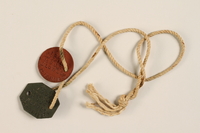
Two military ID tags on a cord worn by a Jewish medical officer, 2nd Polish Corps
Object
Two dog tags on a cord worn by Dr. Salomon Slowes, a medical officer in the Polish Army and the 2nd Polish Corps circa 1939 -1945. Slowes was called up shortly before Germany invaded Poland on September 1, 1939. Three weeks later, the Soviet Union invaded. Slowes was captured by the Soviets and interned in Kozel'sk, Pavlishchev Bor, and Gryazovets prisoner of war labor camps. After Germany invaded the Soviet Union in June 1941, Slowes was released as part of an amnesty granted to Polish prisoners to aid the Soviet war effort. He joined the Polish Army of the East, known as Anders Army, a volunteer military unit. Slowes, who was an oral and facial surgeon, set up clinics in every place the Army made camp. In August 1942, the unit left Soviet territory and became the 2nd Polish Corps, British Army. In February 1944, his unit deployed from North Africa to join the British 8th Army in the Italian Campaign. The Corps fought its way north and was honored for heroism in the May 1944 Battle of Monte Cassino. The Corps was in Italy on May 7, 1945, when the war ended. Slowes was awarded several medals by the British and Polish governments for his service. He settled in Palestine after the war.
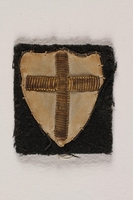
British 8th Army Crusade sleeve patch worn by a Jewish medical officer, 2nd Polish Corps
Object
British 8th Army sleeve patch worn by Dr. Salomon Slowes, who was a medical officer in the Polish Army and later the 2nd Polish Corps, British Army circa 1939-1945. This Crusade shield patch was issued by the Eight Army after June 1944, as an honorary distinction and award for the Corps's heroism at Monte Cassino. It was worn on the right sleeve. Slowes was called up shortly before Germany invaded Poland on September 1, 1939. Three weeks later, the Soviet Union invaded. Slowes was captured by the Soviets and interned in Kozel'sk, Pavlishchev Bor, and Gryazovets prisoner of war labor camps. After Germany invaded the Soviet Union in June 1941, Slowes was released as part of an amnesty granted to Polish prisoners to aid the Soviet war effort. He joined the Polish Army of the East, known as Anders Army, a volunteer military unit. Slowes, who was an oral and facial surgeon, set up clinics in every place the Army made camp. In August 1942, the unit left Soviet territory and became the 2nd Polish Corps, British Army. In February 1944, his unit deployed from North Africa to join the British 8th Army in the Italian Campaign. The Corps fought its way north and was honored for heroism in the May 1944 Battle of Monte Cassino. The Corps was in Italy on May 7, 1945, when the war ended. Slowes was awarded several medals by the British and Polish governments for his service. He settled in Palestine after the war.
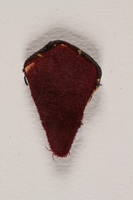
Red medical service collar patch worn by a Jewish medical officer, 2nd Polish Corps
Object
2nd Polish Corps medical service collar badge worn by Dr. Salomon Slowes, a medical staff officer in the Polish Army and then the 2nd Polish Corps, British Army, circa 1939-1945. Slowes was called up shortly before Germany invaded Poland on September 1, 1939. Three weeks later, the Soviet Union invaded. Slowes was captured by the Soviets and interned in Kozel'sk, Pavlishchev Bor, and Gryazovets prisoner of war labor camps. After Germany invaded the Soviet Union in June 1941, Slowes was released when amnesty was granted to Polish prisoners to aid the Soviet war effort. He joined the Polish Army of the East, known as Anders Army, a volunteer military unit. Slowes, who was an oral and facial surgeon, set up clinics in every place the Army made camp. In August 1942, the unit left Soviet territory and became the 2nd Polish Corps, British Army. In February 1944, his unit deployed from North Africa to join the British 8th Army in the Italian Campaign. The Corps fought its way north and was honored for heroism in the May 1944 Battle of Monte Cassino. The Corps was in Italy on May 7, 1945, when the war ended. Slowes was awarded several medals by the British and Polish governments for his service. He settled in Palestine after the war.
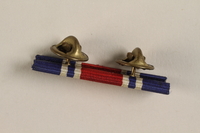
Red, white and blue ribbon bar for distinguished service awarded to a Jewish medical officer, 2nd Polish Corps
Object
Striped service distinction ribbon bar worn by Dr. Salomon Slowes who served as a medical officer in the Polish Army and 2nd Polish Corps, British Army, from 1939-1945. Slowes was called up shortly before Germany invaded Poland on September 1, 1939. Three weeks later, the Soviet Union invaded. Slowes was captured by the Soviets and interned in Kozel'sk, Pavlishchev Bor, and Gryazovets prisoner of war labor camps. After Germany invaded the Soviet Union in June 1941, Slowes was released as part of an amnesty granted to Polish prisoners to aid the Soviet war effort. He joined the Polish Army of the East, known as Anders Army, a volunteer military unit. Slowes, who was an oral and facial surgeon, set up clinics in every place the Army made camp. In August 1942, the unit left Soviet territory and became the 2nd Polish Corps, British Army. In February 1944, his unit deployed from North Africa to join the British 8th Army in the Italian Campaign. The Corps fought its way north and was honored for heroism in the May 1944 Battle of Monte Cassino. The Corps was in Italy on May 7, 1945, when the war ended. Slowes was awarded several medals by the British and Polish governments for his service. He settled in Palestine after the war.
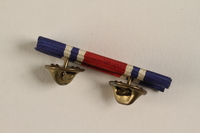
Two place service distinction ribbon bar awarded to a Jewish medical officer, 2nd Polish Corps
Object
Ribbon bar with two service distinction awards worn by Dr. Salomon Slowes, who served as a medical officer in the Polish Army and 2nd Polish Corps, British Army, from 1939-1945. Slowes was called up shortly before Germany invaded Poland on September 1, 1939. Three weeks later, the Soviet Union invaded. Slowes was captured by the Soviets and interned in Kozel'sk, Pavlishchev Bor, and Gryazovets prisoner of war labor camps. After Germany invaded the Soviet Union in June 1941, Slowes was released as part of an amnesty granted to Polish prisoners to aid the Soviet war effort. He joined the Polish Army of the East, known as Anders Army, a volunteer military unit. Slowes, who was an oral and facial surgeon, set up clinics in every place the Army made camp. In August 1942, the unit left Soviet territory and became the 2nd Polish Corps, British Army. In February 1944, his unit deployed from North Africa to join the British 8th Army in the Italian Campaign. The Corps fought its way north and was honored for heroism in the May 1944 Battle of Monte Cassino. The Corps was in Italy on May 7, 1945, when the war ended. Slowes was awarded several medals by the British and Polish governments for his service. He settled in Palestine after the war.
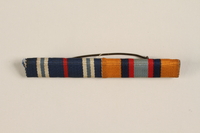
Two place service distinction ribbon bar awarded to a Jewish medical officer, 2nd Polish Corps
Object
Ribbon bar with two service distinction ribbons worn by Dr. Salomon Slowes, who served as a medical officer in the Polish Army and 2nd Polish Corps, British Army, 1939-1945. Slowes was called up shortly before Germany invaded Poland on September 1, 1939. Three weeks later, the Soviet Union invaded. Slowes was captured by the Soviets and interned in prisoner of war camps. After Germany invaded the Soviet Union in June 1941, Slowes was released as part of an amnesty granted to Polish prisoners. He joined the Polish Army of the East, known as Anders Army, a volunteer military unit. In August 1942, the unit left Soviet territory and became the 2nd Polish Corps, British Army. In February 1944, his unit deployed from North Africa to join the British 8th Army in the Italian Campaign. The Corps fought its way north and was honored for heroism in the May 1944 Battle of Monte Cassino. They were in Italy on May 7, 1945, when the war ended. Slowes was awarded several medals by the British and Polish governments for his service. He settled in Palestine after the war.
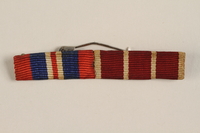
Ribbon bar with British War Medal 1939-1945 and Polish Army Medal for War 1939-1945 awarded to a Jewish medical officer, 2nd Polish Corps
Object
Two place ribbon bar with the British War Medal 1939-1945 ribbon and the Wojska za Wojne [Polish Army Medal for War 1939-1945] ribbon issued to Dr. Salomon Slowes, a medical staff officer in the 2nd Polish Corps, British Army, from 1943-1945. The Polish medal was issued for conscientious service on July 3, 1945, by decree of the Polish Government in Exile. Slowes was called up shortly before Germany invaded Poland on September 1, 1939. Three weeks later, the Soviet Union invaded. Slowes was captured by the Soviets and interned in Kozel'sk, Pavlishchev Bor, and Gryazovets prisoner of war labor camps. After Germany invaded the Soviet Union in June 1941, Slowes was released as part of an amnesty granted to Polish prisoners to aid the Soviet war effort. He joined the Polish Army of the East, known as Anders Army, a volunteer military unit. Slowes, who was an oral and facial surgeon, set up clinics in every place the Army made camp. In August 1942, the unit left Soviet territory and became the 2nd Polish Corps, British Army. In February 1944, his unit deployed from North Africa to join the British 8th Army in the Italian Campaign. The Corps fought its way north and was honored for heroism in the May 1944 Battle of Monte Cassino. The Corps was in Italy on May 7, 1945, when the war ended. Slowes was awarded several medals by the British and Polish governments for his service. He settled in Palestine after the war.
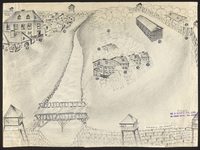
Salomon Slowes papers
Document
The Salomon Slowes papers include biographical materials, correspondence, hand-drawn maps, photographs, printed materials, and writings documenting Salomon Slowes, his family, his experiences in the Polish military, Soviet POW camps, and the Anders Army, and his interest in the Katyn massacre. The papers also include biographical materials, correspondence, photographs, and writings documenting his wife, Mira Slowes, her family, and her survival under a false identity. Biographical materials include student and military records and prescription forms documenting Salomons Slowes’ education and military career; student records documenting Miriam Slowes’ education under her false name; and wedding announcements, business cards, and identification papers documenting relatives and colleagues of the Slowes family. Correspondence includes a handful of Yiddish and Polish prewar and wartime family correspondence among the Slowes and Jezierski families; correspondence from the 1980s to the 2000s with authors Rafael Scharf and Simon Schochet about the Katyn massacre and Holocaust history; and photocopies of a 1941 memo and meeting minutes related to Władysław Anders. Slowes hand-drawn maps depict the Polish-Soviet battles in which he participated in 1939, his capture, and the Soviet POW camps where he was held in Kozel’sk, Pavlishchev Bor, and Gryazovets. This series includes his original maps and annotated reproductions of them. Photographs include prewar and wartime images of Salomon Slowes; prewar images of his family; and wartime images of Generals Władisław Anders and Georgy Zhukov, Bridgadier General Bolesław Szarecki, and the first military parade of the Anders Army. This series also includes a 1938 photograph of the Kozielsk POW camp, a 1929 group photograph of the Union of Zionist Revisionists in Vilna, and a 1978 photograph of professors and students in the Technion Electrical Engineering Department. Printed materials include programs for wartime Polish cultural events in Buzuluk, USSR, and Tehran, Iran; a postwar membership list for a Katyn survivor organization; and articles and clippings about the Katyn massacre, the Holocaust, Israeli politics, Polish, Lithuanian, and Jewish culture, the shtetl at Shchedrin. Writings include personal narratives and historical and medical articles by Salomon Slowes, personal narratives and a medical article by Miriam Slowes, and historical essays by Rafael Scharf. Miriam Slowes’ personal narratives appear to be drafts of her memoir, Moje trzy życia. The Polish version is not perfectly rendered as it was printed from an electronic file created using unidentified Polish software.

